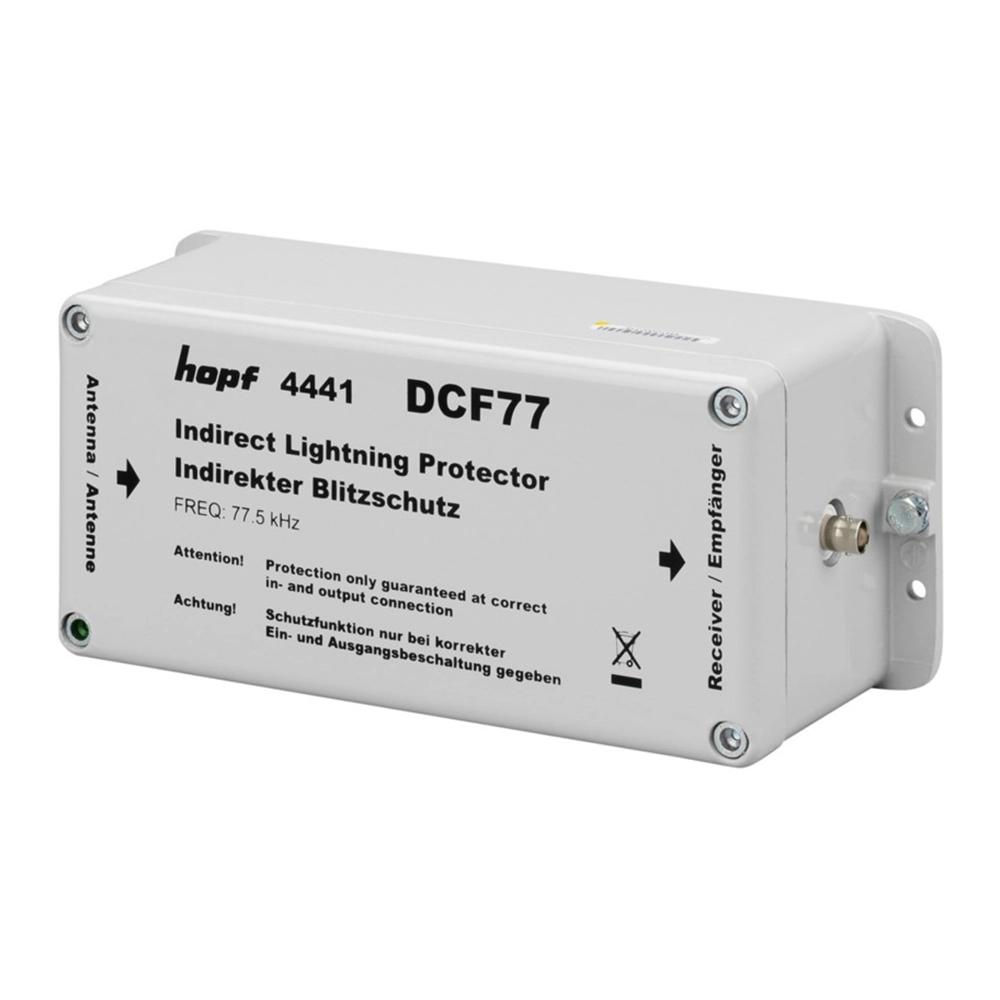توضیح مختصر در خصوص تجهیز حفاظت غیرمستقیم از تجهیزات تایم سرور هوپف در برابر صاعقه ( Indirect Lightning Protection 4441 )
هنگام استفاده از آنتنها در فضای باز، کابلهای آنتن ممکن است با ولتاژهای تداخلی بالا به دلیل توفانها مواجه شوند. این ممکن است باعث از بین رفتن یا آسیب دیدن نه تنها سیستمهای ساعتهای رادیو کنترل شده مستقیما متصل شده، بلکه دستگاههای دیگر متصل شده نیز شود.
برای جلوگیری از هزینههای بالا و آسیبهای بعدی، باید یک حفاظت غیرمستقیم از رعد و برق بین آنتن فضای باز و برد ساعت رادیو کنترلی متصل شود.
برای رسیدن به این هدف، ضروری است که تمام خطوط با ولتاژهای بیش از حد را به سرعت کوتاه کنیم تا آن را کاهش دهیم. یک باری که تداخل تمام شود، دستگاه باید به مشخصات قبلی خود بازگردد. حفاظت غیرمستقیم hopf از یک ترکیب از مؤلفههای مختلف تشکیل شده است.
دیودهای جذب سریع تفاوت پتانسیل بین هسته آنتن و صفر را به طور مداوم نگه میدارند. بعد از آن، گازگیرها، یک بار روشن شده، خط را به نقطه زمینی میکنند. به دلیل این ترکیب، جدا شدن پتانسیل مدار آنتن از الکترونیکهای دیگر حتی در شرایط بدون اختلال تضمین میشود. اگر حفاظت غیرمستقیم از رعد و برق خود توسط یک چشمه رعد و برق از بین برود، خطوط همچنان کوتاه شدهاند. بنابراین هیچ سیگنال DCF77 دریافت نمیشود. ما توصیه میکنیم از بیتهای وضعیت در دستگاههای متصل شده برای بررسی استفاده کنید.
وقتی از حفاظت غیرمستقیم hopf از رعد و برق استفاده میکنیم، فرض میکنیم که یک مفهوم جامع حفاظت از رعد و برق در محل عملیاتی وجود دارد، شامل حفاظت مستقیم از ساختمان طبق VDE و همچنین اینکه تغذیه ولتاژ دستگاه از رعد و برق محافظت شده است. حفاظت غیرمستقیم از رعد و برق معمولاً مستقیماً در جایی که کابل وارد ساختمان میشود نصب میشود. بنابراین، کابلهای داخلی که موازی با کابل آنتن قرار دارند، به حداقل اختلال داده میشوند.
آنتن به اتصال ورودی BNC حفاظت غیرمستقیم از رعد و برق متصل است، و خط گسترده به الکترونیک به اتصال خروجی BNC متصل شده است. یک سیم مسی از پیچ زمین به نزدیکترین نقطه اتصال زمین اجرا میشود.
مهم است که خط زمین دستگاه متصل شده دارای همان نقطه اتصال زمین حفاظت غیرمستقیم از رعد و برق باشد تا از تفاوتهای پتانسیل مخرب جلوگیری شود. اگر این نتواند تضمین شود، حفاظت غیرمستقیم از رعد و برق باید در محل دیگری نصب شود.
اگر حفاظت غیرمستقیم از رعد و برق نزدیک به دستگاه نصب شود، کابل زمین میتواند به زمین دستگاه متصل شود. در این صورت، کابل آنتن بین آنتن و حفاظت غیرمستقیم از رعد و برق نباید موازی با سایر کابلها دویده شود.
در صورت نیاز به چند آنتن DCF77 در یک ساختمان، حفاظت غیرمستقیم از رعد و برق میتواند با یک تقویتکننده آنتن 4 برابر بدون پتانسیل تامین شود.
جعبه حفاظت از رعد و برق حاوی یک تقویتکننده تغذیه و چندین ماژول تقویتکننده است. ورودی آنتن در یکی از سویهای باریک جعبه قرار دارد، در حالی که ورودی کابل برای کابل تامین ولتاژ در سوی دیگر باریک جعبه قرار دارد.
سیگنال DCF77 از طریق ورودی آنتن به یک پیشتقویتکننده تغذیه میشود. سیگنال تقویت شده سپس به 4 مرحله خروجی بدون پتانسیل منتقل میشود، که سیگنال را به اتصالهای آنتن BNC نازلشده انتقال میدهد.
برای اتصال ولتاژ تامین، درپوش جعبه باید با باز کردن پیچها و اتصال کابل از طریق سوراخ ورودی به سرتاسریهای مناسب از برداری شود.
ما دو نسخه از تقویتکننده آنتن 4 برابر را ارائه میدهیم:
FG444400 تقویتکننده آنتن 4 برابر با حفاظت غیرمستقیم از رعد و برق
FG444600 تقویتکننده آنتن 4 برابر
When using outdoor antennas the antenna cables may experience high interference voltages caused by thunderstorms. This may destroy or damage not only the directly connected radio controlled clock systems but also other connected devices.
An indirect lightning protection should be connected between outdoor antenna and radio controlled clock board to avoid high cost and subsequent damages.
Indirect lightning protection 4441
To achieve this it is necessary to short-circuit all the lines with over voltages to reduce it as quickly as possible. Once the interference is over the device is to return to its previous specifications. The hopf indirect lightning protection consists of a combination of different components.
Fast absorber diodes keep the potential difference between antenna core and 0 constantly. The following gas arresters, once lit, short-circuit the line to the earthing point. It is due to this combination that the potential separation of the antenna circuit from the other electronics is guaranteed even in undisturbed situations. If the indirect lightning protection itself is destroyed by a flash of lightning the lines stay shortcircuited. Therefore no DCF77 signal is received. We advise using the status bits in the connected devices to check.
When using the hopf indirect lightning protection we presume that a comprehensive lightning protection concept is in operation on location, including a direct protection of the building according to VDE and also that the voltage supply of the device is protected from lightning. The indirect lightning protection is usually installed directly where the cable enters the building. Therefore in-house cables running parallel to the antenna cable are disturbed as little as possible.
The antenna is connected to the BNC input-connector of the indirect lightning protection – the extended line to the electronics is connected to the BNC-output connector. A copper stranded wire is run from the earthing screw to the nearest earth connection point.
It is important that the earth line of the connected device has the same earth connecting point as the indirect lightning protection, to avoid destructive potential differences. If this cannot be guaranteed, the indirect lightning protection should be installed at a different place.
If the indirect lightning protection is installed near the device the earth cable can be connected to the earth of the device. In this case the antenna cable between antenna and indirect lightning protection should not run parallel to other cables.
4x antenna amplifier with indirect lightning protection 4444
If several DCF77-antennas are required in a building, the indirect lightning protection can be supplied with a 4x potential free antenna amplifier.
The lightning protection housing contains, apart from the indirect lightning protection, a power supply and several amplifier modules. The antenna input is on one of the narrow sides of the housing, whereas the cableinlet for the voltage supply cable is on the other narrow side.
The DCF77 signal is fed to a pre-amplifier via the antenna input. The amplified signal is then fed to 4 potential free output steps, which carry the signal on to the insulated BNC antenna connectors on the broader sides of the housing.
To connect the supply voltage the lid of the housing has to be removed by undoing the screws and connecting the cable through the leading-in hole to the appropriate terminals.
We supply two versions of the 4x antenna amplifier:
- FG444400 4x antenna amplifier with indirect lightning protection
- FG444600 4x antenna amplifier




دیدگاهها0
هیچ دیدگاهی برای این محصول نوشته نشده است.